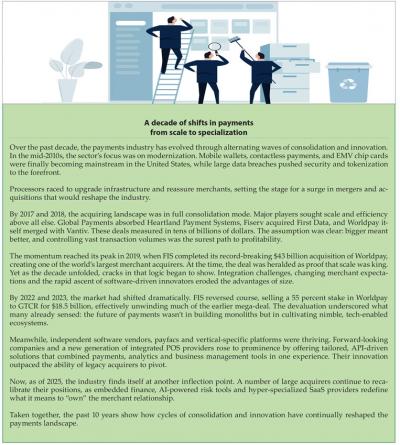The Green Sheet Online Edition
October 27, 2025 • 25:10:02
Consolidation is coming ... still

When younger payments executives ask me about the most significant changes within payments, I usually start with the easy stuff. Integrated solutions. Wireless terminals and chip cards. The truth is a bit more detailed. Authorization costs used to be much higher so instead of running an authorization on every transaction below $50, a physical book was checked to ensure the card was not listed.
This book was updated and sent out weekly to every single merchant. The time merchants took to open and search this warning bulletin made it such that cardholders did not want to engage in smaller transactions. Back then, there were three interchange categories.
Additional categories were implemented to incentivize electronic data capture terminals so that merchants could electronically send their drafts rather than having to bring them to their acquiring bank. This was an enormous shift. Once the merchant was no longer tethered to a physical branch, this allowed for all the innovation that followed.
The rise of consolidation
But even this is not the most seminal change. Ever since merchants were able to process with a nameless, faceless acquirer, consolidation has continued. Consolidation: increasing merchant and transaction count to increase economies of scale in order to decrease processing costs. It happened first on the cardholder side and the merchant side followed that same path.
And while there has been consolidation of large and dynamic acquirers, replacements continue to emerge. While established players like Vantiv, Moneris USA and Cardservice International faded, new entrants like Nuvei, NMI and Shift4 emerged to fill the gap.
I won't analyze or argue that we have larger acquirers now than in the past, or whether the consolidation has happened along the linear pace suggested by the professionally produced power points. But, the most valuable assets, as measured by the multiple of price paid for the asset relative to earnings, is not for large consolidated assets. It’s for the innovators, which have interrupted the consolidation journey.
The last mile, the entity closest to the merchant, owns the relationship. In the past, agents and ISOs were the owners. Now POS system and SaaS providers are demonstrating their value, and merchants are opting for these offerings because of their simplicity.
Failure-proof plan
If being large was the criteria for value, then Worldpay would have sold for a premium. Instead, FIS acquired Worldpay in 2019 for $43 billion. In 2023, when FIS sold a 55 percent stake to GTCR, Worldpay was valued at $18.5 billion. This equates to a deterioration of over $23.5 billion in four years.
Not only did FIS lose out on the appreciation of the $43 billion, but it also lost an additional $23.5 billion. Under Brewster's Millions Rules, I would be hard pressed to lose that much if I worked at it 16 hours per day, seven days per week.
The resistance
Innovations, however, sell at a premium to even the best run portfolios. Mercury Payment Systems was one of the forerunners of the payment integrators. When Vantiv purchased Mercury Payment Systems in 2014, the multiple was nearly 18 times earnings. This was a world away from the sale of merchant portfolios which had valuations of three to seven times and unleashed an entirely new line of payment providers: the integrated software vendor or ISV.
Operators learned that having a unique solution that locked out other clients or provided superior earnings led to valuations far above a normal portfolio. Traditional merchant portfolios multiples looked pedestrian in comparison to the valuation of software companies.
The rise of innovation and software directly led to the deterioration of large static portfolios, like Worldpay. Innovative software companies' merchant bases are protected. These merchants are receiving some additional services, which may be directly or tangentially related to payments.
Examples include integration to a related software or a better POS experience or a vertical-specific solution decked out to that vertical’s providers. Larger providers are caught and unable to pivot quickly. The result is a shrinking portfolio or at least a portfolio that does not grow as fast as an ISV’s.
Specialization over scale
Despite the macroeconomic climate, which favors consolidation, innovative and entrepreneurial companies have thrived. And their numbers are increasing. Micro lending companies, B2B payment gateways, risk platforms, specialized CRMs, payfacs, dispute management companies, statement analysis services and middleware have thrived.
AI has made software development easier and faster, and in some cases, has become the solution itself. Instead of consolidation, these companies have focussed on specialization. Every time the grip of consolidation seeks to build a Borg-like portfolio, an individualistic offshoot is born because the needs of the few are unmet. But, our industry is so large that even a few are enough to build a business.
Financial engineers will always seek to build monoliths. There is way too much money for them not to do so. But, these monoliths will fail specific customers. Larger players will seek to emulate nimble specialized providers, but their heft will prevent execution and specialization.
Entrepreneurs will recognize these failings and speak to these maligned clients. These dedicated, hyper-focused players will dedicate their solution, and their clients will become zealots. The feedback provided will so impact the entrepreneurs, they will seek to share their solution with a much wider customer base and will seek to consolidate on their newly built platform. This consolidation will, in turn, provide new opportunities.
Whenever I see a PowerPoint presentation about the impending consolidation within the acquiring space, I am reminded of G. Michael Hopf’s quote from his post-apocalyptic novel Those Who Remain: “Hard times create strong men, strong men create good times, good times create weak men, and weak men create hard times.”
Hopf, a former Marine turned author, used the line to capture the cyclical nature of struggle and renewal—a pattern that feels strikingly familiar in payments today, as challenges and innovation continue to shape the industry’s next generation of leaders. 
As founder of Humboldt Merchant Services, co-founder of Eureka Payments, and a former executive for such payments innovators as WePay, a division of JPMorgan Chase, Ken Musante has experience in all aspects of successful ISO building. He currently provides consulting services and expert witness testimony as founder of Napa Payments and Consulting, www.napapaymentsandconsulting.com. Contact him at kenm@napapaymentsandconsulting.com, 707-601-7656 or www.linkedin.com/in/ken-musante-us.
Notice to readers: These are archived articles. Contact information, links and other details may be out of date. We regret any inconvenience.





